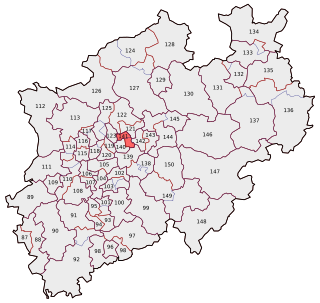Further reading
- Heinz Winter, Königreich Stiepel, Bochum: Hoose (1987)
- Heinz Winter, Von stipula bis Stiepel, 3rd edition (1998)
Stiepel is a southern district of the City of Bochum in the Ruhr area in North Rhine-Westphalia, Germany. It is on the Ruhr River, which is its border to the neighbouring cities of Hattingen and Witten. Stiepel used to be a municipality in the rural district of Bochum, but was integrated into Bochum in 1929.
Stiepel is the most affluent part of Bochum. It has an old village church dating from 1008. Originally a Catholic church, it became a Lutheran church in 1610 when the minister broke away from the church and converted to Lutheranism. The church was honored with a stamp commemorating its 1000th anniversary in 2008.
Stiepel Priory is located in the town.

The Ruhr, also referred to as the Ruhr area, sometimes Ruhr district, Ruhr region, or Ruhr valley, is a polycentric urban area in North Rhine-Westphalia, Germany. With a population density of 2,800/km2 and a population of over 5 million (2017), it is the largest urban area in Germany. It consists of several large cities bordered by the rivers Ruhr to the south, Rhine to the west, and Lippe to the north. In the southwest it borders the Bergisches Land. It is considered part of the larger Rhine-Ruhr metropolitan region of more than 10 million people, which is the third largest in Europe, behind only London and Paris.

Bochum is a city in North Rhine-Westphalia. With a population of 372,348, it is the sixth largest city of the most populous German federal state of North Rhine-Westphalia and the 16th largest city of Germany. On the Ruhr Heights (Ruhrhöhen) hill chain, between the rivers Ruhr to the south and Emscher to the north, it is the second largest city of Westphalia after Dortmund, and the fourth largest city of the Ruhr after Dortmund, Essen and Duisburg. It lies at the centre of the Ruhr, Germany's largest urban area, in the Rhine-Ruhr Metropolitan Region, and belongs to the region of Arnsberg. Bochum is the sixth largest and one of the southernmost cities in the Low German dialect area. There are nine institutions of higher education in the city, most notably the Ruhr University Bochum, one of the ten largest universities in Germany, and the Bochum University of Applied Sciences.

Gelsenkirchen is the 25th most populous city of Germany and the 11th most populous in the state of North Rhine-Westphalia with 262,528 (2016) inhabitants. On the Emscher River, it lies at the centre of the Ruhr, the largest urban area of Germany, of which it is the fifth largest city after Dortmund, Essen, Duisburg and Bochum. The Ruhr is located in the Rhine-Ruhr Metropolitan Region, one of Europe's largest urban areas. Gelsenkirchen is the fifth largest city of Westphalia after Dortmund, Bochum, Bielefeld and Münster, and it is one of the southernmost cities in the Low German dialect area. The city is home to the football club Schalke 04, which is named after Gelsenkirchen-Schalke. The club's current stadium Veltins-Arena, however, is located in Gelsenkirchen-Erle.
The Ennepe-Ruhr-Kreis is a district in the center of North Rhine-Westphalia, Germany. It is part of the southern Ruhr urban area and has ca. 324,000 inhabitants (2012). The district's seat is Schwelm; the largest of its nine towns is Witten.

Since 1975 the former city of Herbede is a part of the city of Witten. As one of the eight boroughs of Witten, it is now called Witten-Herbede. Before the incorporation with Witten in 1975, Herbede was a city in the administrative district Ennepe-Ruhr-Kreis. Herbede is placed about 5 kilometres southwest of the city of Witten in the southern Ruhr area in the Ruhr valley and has about 13,100 inhabitants today. Herbede has good bus connections and is served by bus lines 320, 374, 375, SB38, SB67 and at the weekend by night bus NE17. There are direct bus connections to central Witten, Witten-Annen, Witten-Rüdinghausen, Witten-Heven, Ruhr University Bochum, Wetter, Gevelsberg, Ennepetal, Hattingen and Wuppertal.

Innenstadt is a part of the city of Bochum in North Rhine-Westphalia, Germany including Gleisdreieck. It is located in the Ruhr area, the most populous German agglomeration.

Riemke is a major district of the city of Bochum, Ruhr area, North Rhine-Westphalia, Germany. Riemke borders to the city of Herne. The other districts of Bochum, Riemke borders to are Bergen-Hiltrop, Grumme and Hofstede.

Dahlhausen is a South-Western district of the city of Bochum in North Rhine-Westphalia in Germany. It borders Essen and Hattingen. A large part of the border of Dahlhausen is formed by the river Ruhr. South of the Ruhr is the district of Burgaltendorf of the city of Essen. Dahlhausen houses the well known railway museum of Dahlhausen. The Dr. C. Otto & Comp. is an old company of international importance.

Höntrop is a district of the City of Bochum in the Ruhr area in North Rhine-Westphalia in Germany. The population used to speak the Westphalian dialect, but now standard German is the norm. Höntrop borders inter alia to Freisenbruch, which belongs to Essen, another city, and Linden a district of Bochum. Höntrop belongs to the Stadtbezirk of Wattenscheid. Höntrop is a stop at the railway line S1 to Solingen via Düsseldorf and furthermore also to Dortmund and is starting- and endpoint of the tram line 310 to Heven, a part of Witten via the city of Bochum and Bochum main station.

Bochum-Linden is a district of the City of Bochum in the Ruhr area in North Rhine-Westphalia in Germany. The population's main language was once Westphalian, but it has since been replaced by High German. Bochum-Linden is located in the south west of Bochum, between Dahlhausen and Stiepel. It shares a border with Hattingen, a city of Ennepe-Ruhr-Kreis.
Weitmar-Mark is a suburb of the city of Bochum in North Rhine-Westphalia, Germany. Bochum is in the Ruhr area. The population used to speak Westphalian, but now High German is the norm. Weitmar-Mark is not far from the center of Bochum, between Weitmar-Mitte and Stiepel. Weitmar-Mark is a residential area.

Langendreer is the most populous district of the city of Bochum in the Ruhr area in Germany. Langendreer is between Dortmund, the largest city of Westphalia and Langendreer-Alter Bahnhof, another district of Bochum. Langendreeer includes Kaltehardt, a mainly residential area. Langendreer is in the East of Bochum. Bochum-Langendreer station is one of the largest railway stations in Bochum and the district is also served by Bochum-Langendreer West station. Langendreer used to be one of the main centers of the East Prussian minority in Western Germany.

Wattenscheid is a Stadtbezirk of the city of Bochum. Until 1975, it was a separate town in the Ruhr area of North Rhine-Westphalia. Wattenscheid has a population of about 80,000 citizens. Some notable firms have their headquarters in there, such as Steilmann.

The Bochum-Gelsenkirchener Straßenbahnen AG, abbreviated BOGESTRA, is a public transport operator in the Ruhr area, most notably in the cities of Bochum, Gelsenkirchen and Herne. As of 2012, the company operated, in whole or in part, 9 rail lines, and 65 bus lines. In 2012, BOGESTRA transported a total of 144.9 million passengers. The company is a member of the Verkehrsverbund Rhein-Ruhr (VRR) public transport association.

Stiepel Priory is a Cistercian monastery in Stiepel in Bochum, North Rhine-Westphalia, Germany.

The Essen-Ruhr-Bochum-Langendreer railway is a railway line in the Ruhr region of the German state of North Rhine-Westphalia. Part of it is now disused.

The Bochum/Gelsenkirchen tramway network is a network of tramways focused on Bochum and Gelsenkirchen, two cities in the federal state of North Rhine-Westphalia, Germany.

Herne – Bochum II is an electoral constituency represented in the Bundestag. It elects one member via first-past-the-post voting. Under the current constituency numbering system, it is designated as constituency 141. It is located in the Ruhr region of North Rhine-Westphalia, comprising the city of Herne and the eastern part of the city of Bochum.

The Anneliese Brost Musikforum Ruhr is a music hall for classical music. It is located in Bochum, Germany. It was opened on 28 October 2016. The building consists of three parts: an auditorium holding up to 1026 people, the entrance area in the middle, and a second hall which holds an audience of up to 250 people. The big hall is designed for symphonic concerts, the smaller one for chamber music.